How to remove stuck nozzle off garden hose without damaging it? It is a challenging task. You will need tools, un-stuck methods, and execution of the proper technique to remove the nozzle stuck on the hose.
In this article, we will highlight the step-by-step guide, reasons for a nozzle to get stuck, materials and tools needed, and tips to avoid this problem. Let’s get started!
Contents
Removing a Stuck Hose Nozzle: What You Need to Know
You will face difficulty removing the hose nozzle but this problem can be solved. Using specific tools that are mentioned below. You can also opt for an easier way by using lubricants or any other chemical that can cut down the rust/dirt.
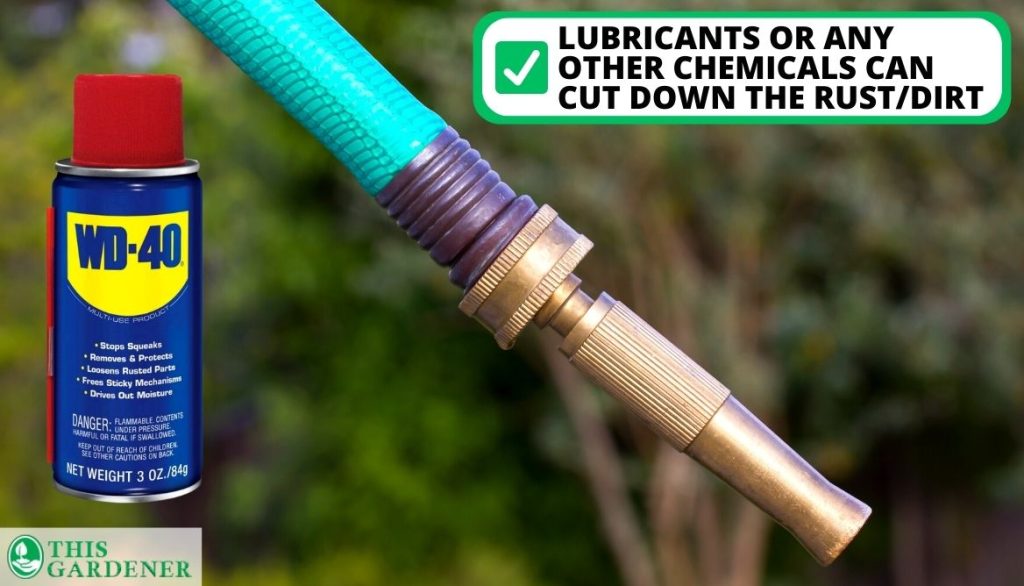
Stuck Hose Nozzle Explained!
It means that even if you turn on the hose it does not discharge water. The hose nozzle may have something jammed in it that is not letting the water pass through and exit the hose. In such a scenario, it is mandatory to resolve the issue and unclog it.
Nozzle Getting Stuck in Garden Hose Issues
Multiple reasons cause issues with a garden hose. Here is a list of some of the reasons!
- Pressure Build-Up: Water pressure build-up can result in the hose getting stuck.
- Tightening of Hose Hozzle: Rust on the threads, dirt, or any other type of debris can tighten the hose nozzle.
- Formation of Deposits: Corrosion can result in deposits that can cause this issue.
- Over Tightening: You may have over-tighten the hose fitting.
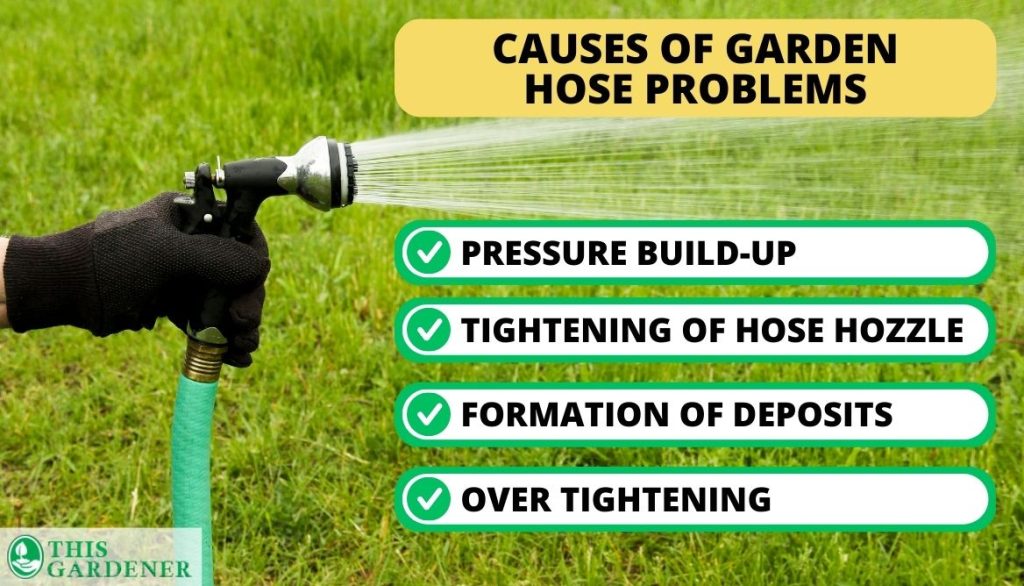
A Step-by-Step Guide On Removing Stuck Nozzle Off Garden Hose
Removing a stuck garden hose requires skill and technique. You need some tools and the proper guide to achieving this without damaging it. Let’s have a look at the things we need and the process!
Equipment Required
To remove or unstuck the nozzle from a garden hose you may need:
- Hammer
- Pipe wrenches
- Blow dryer or hot water
- Lubricant
- Safety gloves (leather gloves)
- Plier
- Hair dryer
- Optional: Hacksaw, vinegar, lime, Petroleum based lubricant
Steps for Removing Garden Hoses/Nozzle
Removing a nozzle from the stuck garden hoses may seem like a simple feat but it can become challenging if the nozzle gets stuck. It can be annoying and removing it without damaging the nozzle or the hose requires skillful work.
Below are the steps that can help to unstick it without causing any damage. Let’s get started!
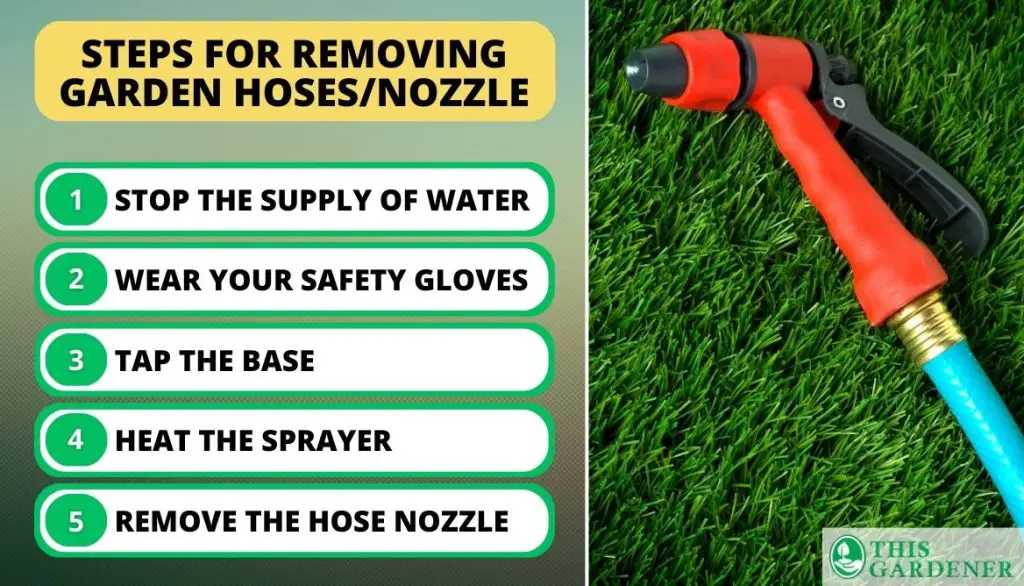
1. Stop the Supply of Water
Before you start doing anything with the hose, you need to cut off the water supply. There may be pressure buildup or debris stuck in it.
To avoid further blockage or splashes this is a major step. If you are using a high-pressure hose then this is very important as unscrewing without doing this can make it a difficult process.
2. Wear Your Safety Gloves
Protective gear is a must and there are no compromises on safety of any kind.
- In this case, you need safety gloves while using the tools to remove the nozzle and connectors.
- After putting on some gloves, use a plier and start to unwind the base of the nozzle.
3. Tap the Base
Corrosion is one reason that the connectors may be stuck.
Using a Hammer
Gently tap on the base with a hammer and ensure you do not hit it too hard. Tapping it with the hammer to shed the excess corrosion and make it easy to unwind.
Pipe Wrench
Another great trick is to use a pipe wrench to turn the connectors clockwise and anti-clockwise. This will loosen the hose fitting/threads and make it easy to remove the sprayer.
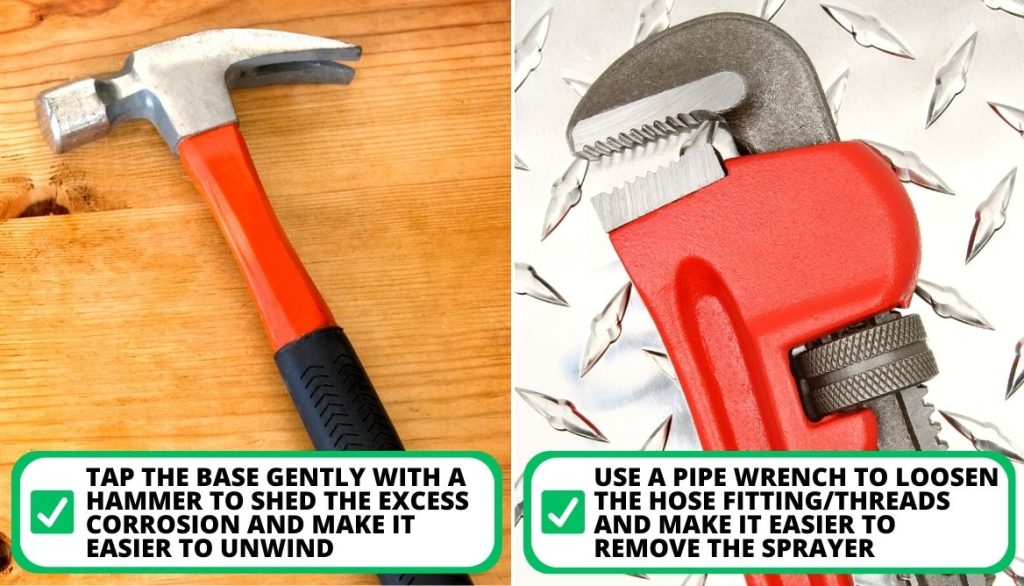
4. Heat the Sprayer
An easy way for loosening the hose fitting and the nozzle is by applying heat to it.
- You can use a hair dryer for this purpose or simply boil water and slowly pour it on the fittings/connectors of the hose end.
- Applying heat contracts the metal, making space between the threads, and helps to turn the connector with the wrench with minimum effort.
- Check if the base is heated, now be careful and unscrew the remaining components by hand, pipe wrenches, or pliers.
5. Remove the Hose Nozzle
It is possible that dirt, debris, or corrosion might be jamming the threads. Follow these tips to remove the hose nozzle:
- Applying some lubricants can help to loosen the nozzle.
- Spray some WD-40 (rust remover) on the hose end and let it dry.
- If you do not have a lubricant then squeeze a lime as an alternate.
You can also watch this video for further help.
Alternatives to Remove a Stuck Nozzle Off Garden Hose
If the above-mentioned methods do not work for you then there are other simple tricks that can remove the nozzle from the garden hoses. Read on and learn it!
Removing a Hose by Twisting
To remove stuck hose end fittings, use two tongue-and-groove pliers or two wrenches (pipe) to gently twist the fitting.
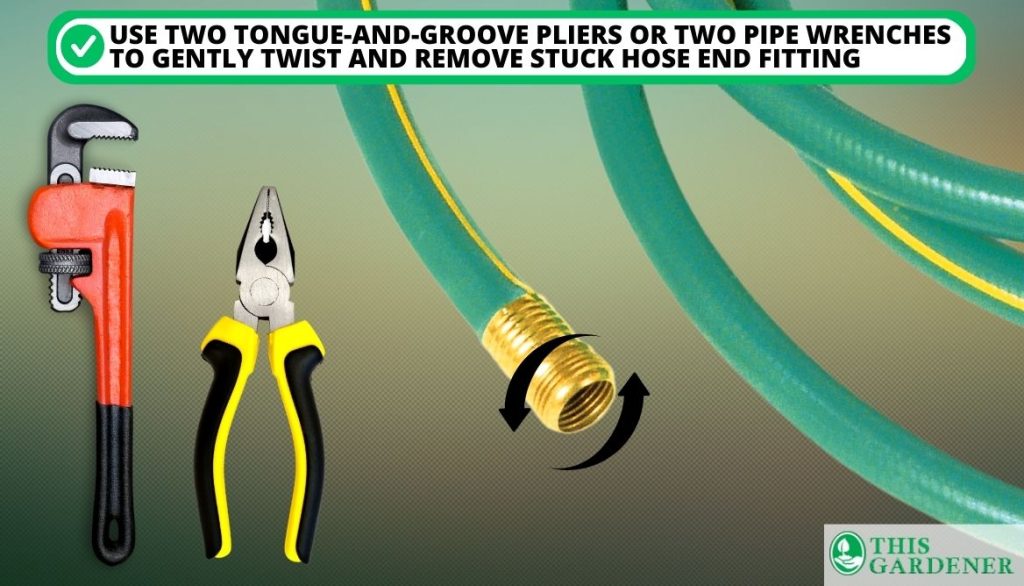
Avoid damaging the spigot by holding it securely with the other tool and adjusting the tool so all three edges rest against the hose fitting. Apply lubricants, rust-busting products, or heat from a heat gun or hair dryer to help loosen the grip.
Removing a Hose Using a Hacksaw
If the hose fitting is stuck, use a hacksaw as a last resort to cut it at a 45-degree angle, being careful not to cut too deeply and avoid damaging the threads on the spigot. Create enough of a slot to insert a screwdriver and pry out the fitting to twist it off.
How to Avoid the Problem
Follow these important tips to avoid any inconveniences:
- Aluminum corrodes from moisture so removing the hose from the fittings at least 2-3 times a year will help you prevent this issue.
- Choose brass fittings as they do not corrode resulting in the hose not getting stuck.
- Upgrade your hose end and spigot by installing a “quick connect device”! Now you can snap the hose into the spigot with just a push-and-click system.
- There are no threads or fittings to tighten there is no deposit of debris in between.
Important Tips on Getting a Stuck Hose Nozzle Off
Here is a list of tips that will help you to resolve a stuck hose nozzle problem. Let’s check it out!
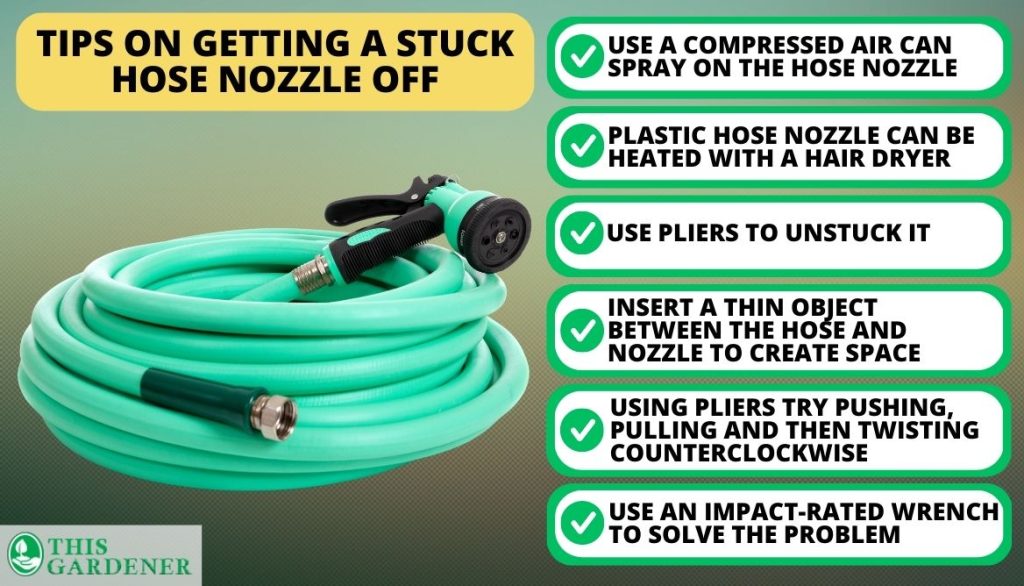
- Use a compressed air can spray on the hose nozzle. The cool air will contract the metal and make space to turn it.
- If the hose nozzle is made from plastic then heating it with a hair dryer will do the trick. The plastic will expand allowing you to easily twist and turn it.
- Make use of pliers to unstuck it. Put a piece of cloth around the hose side for a firm grip and then twist it counterclockwise.
- Insert a thin object or a utility knife between the hose and nozzle then apply gentle pressure to try to create some space.
- Try applying pressure by pulling and then twisting it counterclockwise with pliers.
- Use an impact-rated wrench to solve the problem. Attach it to the hose end and apply pressure to twist it open.
FAQ
How do you open a stuck garden hose?
To open a stuck garden hose, turn off the water source, and release the pressure. Now apply a lubricant (e.g. WD-40) on the connection. Use a plier to twist open the connection. If it is tightly stuck, you can heat it to help unwind the connection.
How do you loosen a garden hose connector?
To loosen a garden hose connector, applying a lubricant or connector to the connection can help loosen up the rust and result in a smooth unwinding process. Applying heat to the connector can also help a lot to loosen the connector.
How do you get a stuck nozzle off a garden hose?
To remove a stuck nozzle of a garden hose, you can use the right tools such as a plier or an adjustable wrench.
It is easier if you use a lubricant to remove any rust or debris between the windings. Lastly, heating the pipe can expand the connector and loosen the connection from any obstructions.
What happens if you leave the water hose on with a nozzle?
If you leave the water hose on with the nozzle then the immediate problem will be flooding in the backyard or garden. Also, it can result in rusting or pressure build-up that can damage the plumbing.
What can damage a hose?
Multiple factors can damage a hose end such as increased exposure to sunlight can result in damage, chemicals (e.g. acids, bleaching agents, etc), handling the nozzle roughly, tension/stress/overstretching of the nozzle, and freezing temperatures.
Conclusion
There are multiple factors that result in a stuck, clogged, or jammed hose and nozzle. Replacing the hose end and nozzle is challenging although using a pair of locking pliers handy work is made easy.
Be careful. metal can cause injury so wear something to protect yourself while using pliers on the thread or trying to replace any component. How did you remove the nozzle? Which method best suited your problem? Let us know in the comments section.
- How to Get Potatoes to Sprout Eyes: Detailed Growing Guide with 3 Options - July 31, 2023
- Weight of a Medium Potato: Revealed in Detailed Guide - July 29, 2023
- Maris Piper Potatoes: 9 Substitutes You Should Know About - July 27, 2023
Hello! I’m Jessica Zander, a garden coach and consultant based in the Boston area (zone 6b), offering virtual consultations across the country and Canada.
I’ve been passionate about gardening since the early 1990s, and in 2022, I launched You Can Do It Gardening to empower individuals to feel more confident in their gardening endeavors.
Following a 30-year career in nonprofit finance and operations, I transitioned out of that field in mid-June of 2023 due to the growing demand for coaching services. Interestingly, my years of presenting financial statements to boards and finance committees proved to be valuable experience for teaching people about gardening! I enjoy sharing skills, providing guidance and suggestions, and collaborating efficiently with clients to make significant improvements to their outdoor spaces, both small and large. I also regularly teach at the Arlington Continuing Education and Cambridge Adult Education.
My approach is direct and practical, akin to Mary Poppins, but tailored to your garden. Clients find satisfaction in saving money and taking pride in their own gardening achievements.

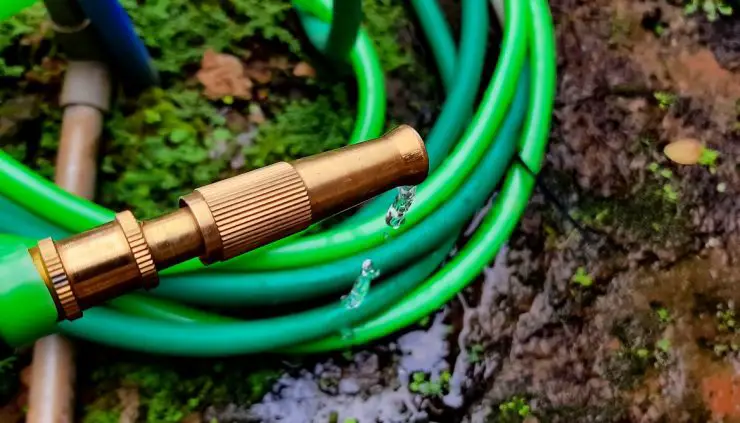
Add comment